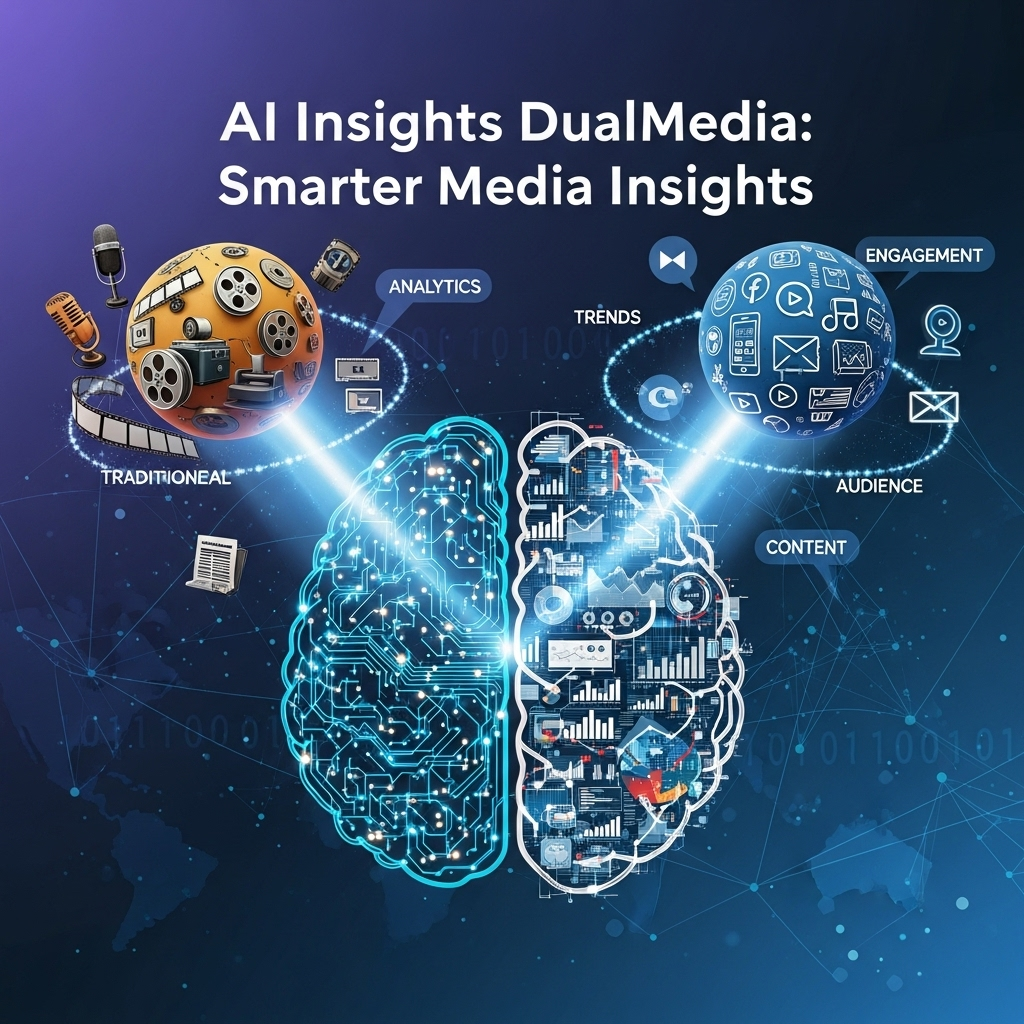Introduction to AI Insights DualMedia
Artificial intelligence, is becoming a major factor behind new ideas in almost every field, from healthcare to entertainment. AI Insights DualMedia is one of the most interesting new ideas in the last few years. It combines advanced AI analytics with the capacity to understand and synthesise information from many media sources. DualMedia combines information from two or more types of content, such text and video, instead of just one type of data. This method gives organisations a fuller, more detailed view of events, which helps them make better judgements. In today’s fast-paced digital world, having such an integrated vision is necessary to stay ahead of the competition.
Understanding the Concept of AI Insights DualMedia
DualMedia in AI means that Artificial intelligence systems may combine information from at least two different types of media, such as text, photos, audio, or video. This approach is not like traditional analytics, which may only look at one channel at a time. AI can find patterns, connections, and insights that would be impossible to find otherwise by combining different streams of information. For example, looking at both the text and the image that goes with a social media post might give you a better idea of the context and the mood. The idea is to create a multi-layered understanding that is similar to how people take in and absorb information.
Core Technologies Behind AI Insights DualMedia
Machine Learning (ML) Foundations
Machine learning is what makes AI Insights DualMedia work. It lets systems find patterns in different kinds of data. ML systems learn from big collections of data that include examples from different types of media. This helps them generate predictions and classifications. As they have more data, these algorithms get better over time. Integrating different sorts of content would be almost difficult without machine learning. It lets AI deal with the intricacy of cross-media relationships, which makes sure that users get accurate and useful information.
Natural Language Processing (NLP) for Content Understanding
Natural Language Processing lets AI systems understand and analyse spoken and written language. NLP is used in DualMedia to process text, captions, and transcripts along with audio or video input. This lets the AI figure out what things mean, figure out how people feel about things, and grasp references in context. Without NLP’s deeper linguistic analysis, a sarcastic tweet with a picture can be misread. With NLP, the system can put together the literal meaning of words with their tone, feeling, and cultural differences.
Computer Vision for Visual Media Analytics
AI can understand pictures and videos thanks to computer vision. It can tell what things are, who they are, where they are, and even how they feel. Computer vision and natural language processing (NLP) work together in DualMedia systems to give a full picture of multimedia content. For example, a product review might have a video showing how to use it. Computer vision can look at the video while NLP looks at the written evaluation. This combination enables firms and researchers understand both the words and pictures that people use to give feedback.
Neural Networks and Deep Learning Role in Automation
AI can handle a lot of complicated data with little help from people thanks to neural networks, especially deep learning models. In DualMedia, these models can learn how multiple types of media are related to one other in complex ways, including how facial emotions in a video connect to the spoken dialogue. Deep learning makes sure that the AI becomes better and better over time, which is why it is so useful for real-time tasks like covering breaking news or analysing live events. The automation it enables speeds up processes and lets insights be supplied faster than ever before.
How AI Insights DualMedia Works
The first step in the process is data collection, which is when the system collects text, pictures, videos, or audio from a number of different places. This might be anything from news stories and social media posts to surveillance videos and more. The data is cleaned and organised for analysis after it has been gathered. AI algorithms then use unique tools like NLP for text and computer vision for images to process each form of media separately. Finally, the information from both streams is combined together into one output. This method lets those who make decisions recognise connections that would be hidden if each medium were looked at on its own.
Benefits of AI Insights DualMedia
One big advantage is that insights are more accurate since combining different sources makes it less likely that they will be misinterpreted. Companies can also look at different types of content, which makes it easier for them to respond to trends in real time. Because insights are more detailed and relevant, decisions can be made more quickly. Another benefit is better personalisation. Marketers may customize material based on what people say and how they show it visually. In the end, AI Insights DualMedia helps businesses work better in circumstances that are competitive and based on data.
Business Applications of AI Insights DualMedia
Marketing & Advertising
AI Insights DualMedia can look into both ad copy and videos of customers reacting to ads to see how engaged they are. This two-part study lets marketers see not just what people say, but also how they react emotionally or visually. Finding the best combinations of pictures and messages can help campaigns do better. It also allows marketers to perform deeper sentiment analysis, spotting subtle cues like hesitation or excitement. This knowledge makes advertising efforts more focused and useful.
Journalism & Media Monitoring
AI Insights DualMedia can help journalists check the truth of news stories by comparing written statements to pictures. For example, AI can tell if a video clip matches the event that an article talks about. By looking at live broadcasts and social media posts, media monitoring companies may also keep an eye on breaking news trends. This makes reporting faster and stops the spread of false information. The news process is more trustworthy and believable when sources may be combined.
E-commerce & Retail
Retailers can utilise DualMedia to combine customer feedback with videos of people opening products to improve quality control. AI can find patterns in both text and images to figure out what problems or strengths are common. Companies can use this information to make their products and marketing plans better. Also, you can make personalised suggestions by looking at how customers interact with and talk about product visuals. It is a great way to make shopping better.
Education & Training
AI Insights DualMedia can look at both written answers and video-recorded presentations in school to see how well a student understands a topic. This makes the grading system more complete by taking into account both verbal and non-verbal communication. Online course providers can also look at how students use instructional videos and discussion boards to make lessons more useful for each student. This makes the learning environment more flexible and useful.
Key Features of AI Insights DualMedia
Multi-Format Data Fusion
AI Information DualMedia does a great job of bringing together text, audio, video, and image analysis into one screen.
This combination gives you a better, more contextual understanding than analytics that only look at one type of media.
It finds hidden patterns and connections by looking at different forms together.
Organisations get a more complete view, which helps them make better decisions by filling in gaps.
Instant, Real-Time Intelligence
The platform processes live data streams to deliver insights in seconds, not hours.
From breaking news to viral social trends, it ensures you never miss critical developments.
This rapid response capability is vital for industries where timing determines success.
It empowers teams to act decisively and capitalize on emerging opportunities instantly.
Deep Sentiment and Emotional Context Detection
DualMedia goes beyond only reading feelings; it also reads tone, mood, and visual cues to get a deeper meaning.
It uses both NLP and computer vision to figure out what people mean and how they feel.
This stops people from misunderstanding things and gives more accurate audience profiles.
Marketers, analysts, and journalists can get people’s attention more accurately.
Predictive Trend Forecasting
The method analyses both past and present data to make predictions about what will happen in the future and how people will act.
It looks for patterns in different types of media to predict changes in the market or audience.
Instead of waiting for changes to happen, businesses can proactively adapt their plans.
This foresight lowers risk, makes you more ready, and gives you a bigger edge over your competitors.
Unified Cross-Platform Integration
DualMedia pulls information from multiple channels—social feeds, news outlets, and internal databases.
It eliminates data silos, ensuring all insights live in one centralized ecosystem.
This connected approach strengthens interdepartmental collaboration and strategic alignment.
Decisions become more informed because they’re based on a unified truth source.
Adaptive and Customizable Dashboards
Users can customise dashboards to show the KPIs and insight categories that are most important to them.
Interactive visualisations make it easy to understand complicated multi-media data.
The ability to customise makes it useful for a wide range of fields, from retail to security.
It makes workflows easier by just sending the most important information.
Case Studies of AI Insights DualMedia in Action
During big events, one global news organisation uses AI Insights DualMedia to mix live video feeds with comments from social media in real time. This lets reporters quickly find out how people feel about something and find out about breaking news. A major streaming service in the entertainment business uses the Technology to suggest shows by looking at both viewing habits and user feedback. Sports teams are also using technology to combine game footage with player stats, which helps coaches come up with better game plans. Each example shows how combining different sources of data gives you deeper, more useful insights.
Challenges and Limitations of AI Insights DualMedia
AI Insights DualMedia has a lot of potential, but it also has certain problems, like worries about data privacy, especially when looking at personal media content. Bad data or missing information from one source can also make accuracy worse. AI bias is another problem. This happens when algorithms misinterpret material because the training data is biassed. Also, the technical infrastructure needed for real-time, large-scale processing might be costly. To make long-term use possible, these problems must be solved.
Solutions and Best Practices of AI Insights DualMedia
Companies should use robust encryption and follow rules like GDPR to address privacy issues. To reduce bias, it’s important to regularly retrain AI models with a variety of datasets. Putting money into strong data-cleaning techniques makes sure that the analysis is better. A lot of companies also use a mix of AI and human workers, where AI does most of the work and people check the findings. If you follow these best practices, AI Insights DualMedia will give you results that are dependable, ethical, and scalable.
Future Trends in AI Insights DualMedia

We can expect future systems to integrate with AR/VR for immersive analytics, allowing users to experience data in a 3D environment. Predictive analytics will also play a larger role, helping organizations anticipate trends before they occur. Cross-lingual AI will enable analysis of global media without language barriers. As processing speeds improve, real-time DualMedia analysis will become the standard, powering everything from live sports commentary to instant crisis response. These trends will expand the technology’s reach and impact.
The Path Forward with AI Insights DualMedia
From Competitive Advantage to Necessity
As AI technology improves, multi-format analytics will no longer be a nice-to-have; it will be necessary.
Companies who use AI Insights DualMedia early will get faster responses, better predictions, and better strategy.
Being ahead of the curve is the only way to not just survive but also dominate in marketplaces that are driven by data.
Integration with Emerging Technologies
In the future, DualMedia will work with AR, VR, and advanced predictive modelling.
These integrations will let people encounter data insights in new and exciting ways.
This change will turn analytics from static reports into real-time, interactive experiences..
Ethical and Responsible AI Adoption
When you have more power, you also have more responsibility, especially when it comes to data privacy and ethics.
AI Insights DualMedia’s future will depend on following the rules of AI governance as they change.
Responsible adoption will build trust, openness, and long-term success.
Becoming a Cornerstone of Decision-Making
In the next few years, DualMedia will be very important in business, school, and the media.
It will change the way we understand information by being able to combine text, images, and sound.
People who accept it now will be moulding the future instead of just going with the flow.
Conclusion of the AI Insights DualMedia
AI Information DualMedia is a big step forward in how businesses handle and make use of data. By bringing together information from many different media sources, it gives a fuller, more contextual picture than analytics from just one source. It may be used in many fields, including as marketing and education, and it has benefits like better accuracy, faster decision-making, and more personalised experiences. There are still problems like bias and privacy, but best practices and new ideas are making it easier for more people to use these tools. Companies who use this technology will be better prepared to do well in a future where data is important.
Frequently Asked Questions (FAQs) of AI Insights DualMedia
What industries benefit most from AI Insights DualMedia?
Industries such as marketing, journalism, e-commerce, and education benefit greatly due to the technology’s ability to merge different types of media for richer insights.
How does DualMedia differ from single-source AI analytics?
DualMedia analyzes at least two media types together, offering a more comprehensive and accurate perspective compared to single-source methods.
Can AI Insights DualMedia work in real-time environments?
Yes, with the right infrastructure, it can deliver insights almost instantly, making it ideal for live events and fast-changing situations.
What are the biggest risks of using AI Insights DualMedia?
The main risks involve privacy concerns, data quality issues, and the potential for AI bias.
How can businesses get started with AI Insights DualMedia?
Start with small pilot projects, ensure data compliance, and gradually scale the system while continuously training AI models for accuracy.




